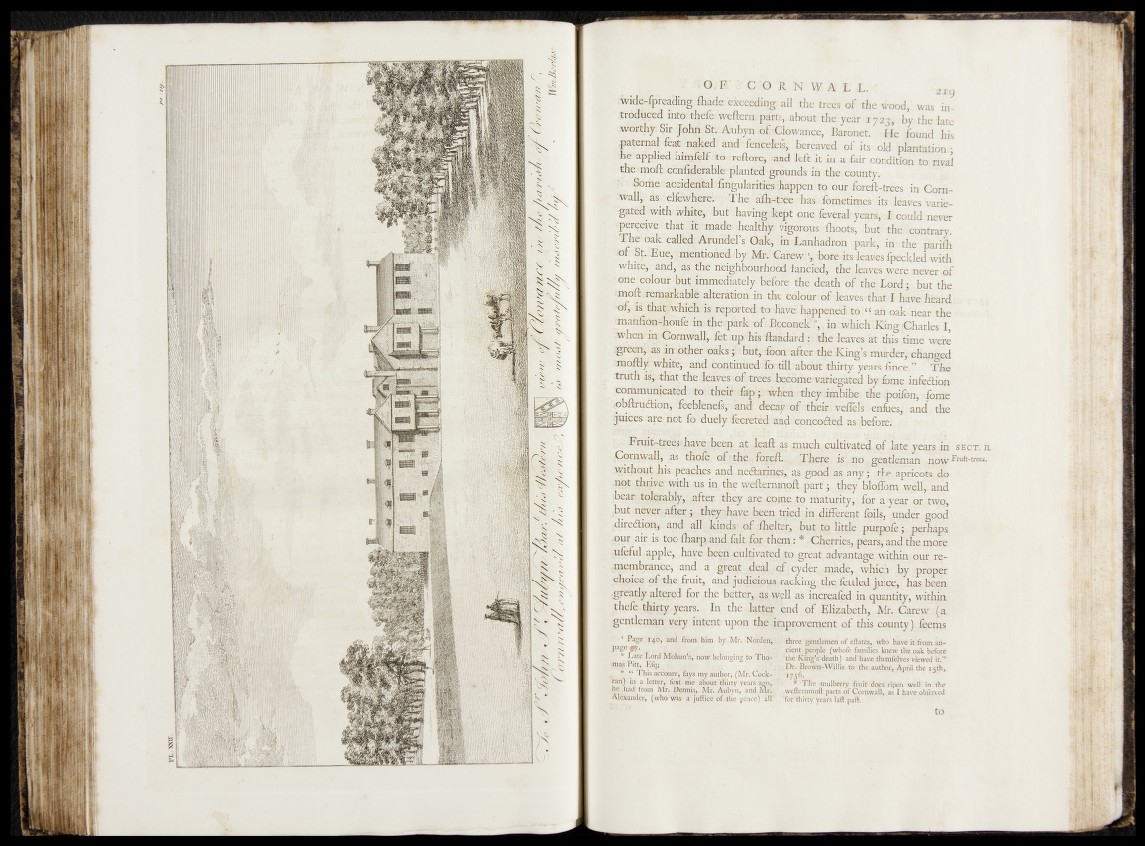
î
■ 0 -] F. 2 C O R N W A L L. 2tg
wide-lpreading lhade. exceeding, all the trees of the wood,' was introduced
into thefe weftern. parts,. about the year 172/3:,, by the late
worthy. Sir John St.- Aubyn of Clowance, Baronet. He found , his
paternal feat naked of its old plantation •
ap^l^e'd himfelf to reftore; and left it in a fair condition, to rival
the molt considerable planted grounds in the county..
Some accidental: fiogularities happen to our foreft-trees in Corn-
wal1’ as. -elSewherei The alh-trce has. fometimes • its leaves variegated
with white, but having kept one feveral years, I could never
ipcreewe that it made healthy vigorous Ihoots, but the contrary.
The oak called Arundel’s; Oak, in Lanhadron park,, in the parifh
of St.-Eue, mentioned rby Mr. Ca r cwbor e its leaves Ipockledwith
I white, and, as the neighbourhood fancied,, the leaves were, never .of
:me colour but immediately before the death of the Lord; but the
moft. remarkable alteration in the colour of leaves that I have heard
•of, la that: which is reported.to: have.happened to “ an oak near the
manfion-houfe in. the- park o f Bpconefe", in which Ring Charles I,
when in Cornwall, fet up. his ftaridard : the leaves-at this tfime wehe
iffibther, the JOngs mi^rder, diapgpcj
aM fcoy^hddJfoTtffl^bcfet fhhty yea® .h£tee.^pThe
^ t h is;>^t_ilffi:.iyfesydi treeslhqcame,'^^ke^ bylfeme infedian
Eorhmu^eatid. to d:h rfrd ap ;; wheh ;jdiey?awbibe; the pcalon, ibmie
^bftni^aon; ?^kdendspAnd decaycof ihtikfvdfeB^^ enfiie^iand the
juices. -ape not fo duciydecBetedand cpqc®9jbd asubefoEe; jtt
bf betai ,aL>leaft -much (cultivated,of late years:in sect. it.
Cornwall, as. thole of the • foreif.. There is no gentleman nowFruit-trees,
without his peaches and nedarines/ as good as any; the apricots do
not thyke with us. in the wefternmoft part; they bloffom well, and
bear tolerably,- after they are come to maturity, for a year or two,
but never after; they' have- been tided in different foils, under good
direction,- and all kinds? of .Ihelter, but to little purpofe; perhaps
our hr is too lharp and .fait for them: * fe r r ie s , pears, and the more
yifefuljipple, h&yd-beeri .cultivat^fe great radyantage within pur ye-
.membrance, and a great deal-of ? cyderc.made, which by proper
,ehoic§ of the .fruity andjudiwu^racking thefettled juice, has beep
.greatly altered for the better, as well as increafed in quantity, within
thefe thirty .years. In the latter end of Elizabeth, Mr. Carew (a
gentleman very intent upon the improvement of this county) feeiiis
; •* Page 140, and from him by Mr. Nord en;
JPage ; i
' 1 Late Lord Mohun’s, now belonging to Thomas
Pitt,- Efq;
w « This account, fays my author, (Mr. Cocfc-
•ràif) in a letter, fent me about thirty years ago,?
he hath from Mr. Dennis, Mr. Aubyn, and Mr.
Alexander, (who was a jufticc of .the peace) ill ’
three gentlemen of eftates, who have it.from ancient
people (whole families knew the Oak before
’ the KingVdeath) and have themfelves viewed if.”
Dr. Brown-A-Villis to . the author, April- the 15th,
» The mulberry fruit does ripen well in the
^ weftern moft. parts of Cornwall, as I have pbferred
f a f l y e a i l laft paft,-
to